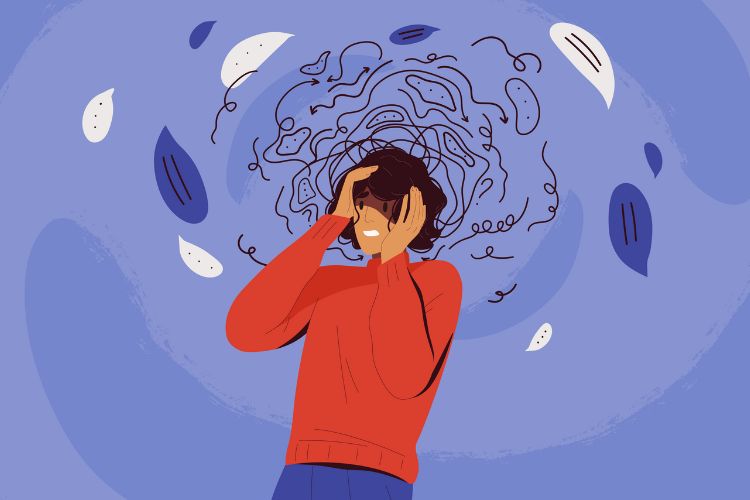Anxiety is a serious health concern affecting millions, including veterans. According to the Department of Veterans Affairs or VA, nearly 10% of all service members experience elevated anxiety levels. Thankfully, the VA offers some disability compensation for veterans with anxiety related to their military service. If you or someone you love has served in the military, you need to read this article to learn more about anxiety and VA disability and how you can apply for and receive compensation.
Understanding Anxiety Disorders
Before learning how to apply for anxiety VA disability benefits, it’s essential to understand these disorders. They refer to a group of mental health conditions that cause excessive stress and worry. A VA claim for anxiety often focuses on specific anxiety types, depending on your service. You also receive a VA rating for anxiety that affects how much you get based on your symptoms. Let’s break down the most common types of anxiety to help you understand your anxiety VA claim better.
Anxiety Disorder Types: They Will Vary Heavily
The most common anxiety disorder is probably generalized anxiety. This condition causes fears about general things, including commuting to work, your family’s safety, and the potential of war. The generalized anxiety disorder VA rating or GAD VA rating typically sits at about 50%, which we’ll discuss later to ensure you better understand that term and how it affects you.
That said, veterans may experience many types of anxiety disorders that impact their overall health and safety. These conditions can vary heavily but often cause excessive fear and doubt, making your life hard to manage. Just a few common anxiety types include:
- Panic Disorder: People with this condition often feel fine but suddenly develop extreme panic that affects how well they function.
- Social Anxiety Disorder: Veterans with SAD may struggle to interact in social groups and leave their homes.
- PTSD: Post-traumatic stress disorder often occurs in veterans with active military service and triggers depression, flashbacks, extreme anxiety, and other symptoms.
- Phobias: An unreasonable fear of something like loud noises is called a phobia and classifies as anxiety. Many veterans feel phobic about gunshots or even fireworks.
Symptoms and Causes of Anxiety
Veterans experience anxiety for many reasons, including difficult experiences while serving and the death of fellow soldiers. Some people are naturally inclined towards anxiety and feel worsened symptoms after service. Other soldiers may develop anxiety after service without any prior symptoms. The following signs all indicate that you or a loved one have some form of anxiety disorder:
- Extreme restlessness or feeling on edge
- Troubles with your energy level, such as increased fatigue
- Difficulty concentrating or easy irritability
- Pounding or racing heart and severe sweating
- Sudden fear without any cause
- Feelings of impending doom or being out of control
- Stomach and head pains
- Self-conscious feelings of negativity
- Excessive fear caused by an irrational concern
How Anxiety Affects Veterans
Anxiety can adversely affect a veteran’s life in many ways. For example, it:
- Triggers difficult depression that makes their post-service life challenging
- Causes social problems that can impact them for many years
- Makes finding work harder after completing their service
- Develops other mental health disorders alongside anxiety
- Increases their risk for substance abuse disorders
Thankfully, you can claim anxiety in the VA disability system. They’ll set a specific rating that affects your payments and your treatment.
VA Disability Ratings for Anxiety Disorders
When examining anxiety and VA disability, you must understand the VA disability rating system. This unique concept helps classify various conditions and allows the VA decide how much compensation you receive. As a result, you must know your VA rating for anxiety before making a VA claim for anxiety. Your VA disability anxiety rating will likely vary heavily and affect an anxiety VA claim’s success.
The VA Disability Rating System Explained Briefly
When applying for anxiety VA disability, your issue will be given a percentage rating based on how heavily your condition affects your life. This rating dictates how much compensation you receive monthly and your eligibility for other benefits from the VA. The percentage you receive rates how much your condition affects your overall health and ability to function.
Note that the VA considers multiple disabilities that can affect your overall compensation. For example, your anxiety and VA disability rating may be just 30%, but your overall rating could be 70% if a leg injury causes a 40% disability. Your rating maxes out at 100%, as the VA understandably states that a person cannot be more than 100% disabled.
How the VA Ranks Anxiety Disorders
The VA takes anxiety disorders very seriously and will rank yours using the system they use for physical health issues. They start by assessing your mental health through various counseling sessions and taking evidence from other experts. This evidence can include testimonials, written diagnoses, and conversations with family members highlighting your concerns.
The VA uses in-depth criteria to create your disability rating. For example, they will consider multiple factors, such as:
- The frequency of your anxiety
- The severity of your anxiety attacks
- The duration of your symptoms
- How long your remissions last
- The extent of your social experiment
- Whether a neurocognitive disorder also worsens your anxiety
- Other problems it may trigger in your life
Anxiety is typically classified as a disability when it affects your ability to function happily, such as struggling to find a job after military service or interacting successfully with others. If you’re unsure whether your anxiety will qualify, look at the examples below to better understand.
A Few Examples of VA Disability Ratings
The following examples should help you better understand percentage rankings for disability claims and how the VA assesses cases like these:
- 0% Rating: Your doctor diagnoses you with an anxiety disorder, but the VA finds that it doesn’t affect your social functioning because you don’t need medication.
- 10% Rating: You need medication for your symptoms, or you struggle with work efficiency when stress levels increase. However, you can function fine outside of stressful scenarios.
- 30% Rating: Occasionally, you experience depression, panic attacks, sleep impairment, and slight memory loss. These require medication to manage and adversely affect your work.
- 50% Rating: You experience almost daily panic attacks and impaired judgment and struggle to produce reliable work. Without your medication, you simply can’t focus on your daily life.
- 70% Rating: Suicidal ideation, nearly continual panic, struggles with depression, and poor relationships all frequently occur in your life. Your doctor has you heavily medicated to prevent suicidal actions.
- 100% Rating: Anxiety makes it impossible for you to hold down a job or maintain relationships, and you experience impaired communication, inappropriate behavior, and other symptoms.

Applying for VA Disability Benefits for Anxiety Disorders
The application process for VA benefits for anxiety is not as complex as you might expect. While it does take time and some research to prove your case, many get approved due to the complexities of mental health and increasing awareness of its impact on a veteran’s life.
Eligibility Criteria for Disability
When applying for anxiety VA disability benefits, you must meet several requirements. First, you must have a current illness or injury that affects your mental health. For example, if you have been diagnosed with PTSD or generalized anxiety disorder, you meet this requirement. You must also have served in the military on either active duty, duty for training, or inactive duty training.
If you meet these criteria, you must also meet at least one other to ensure that you get some compensation. Failure to meet at least one of these criteria will limit your eligibility and could trigger a denial. They include:
- Developing your anxiety while in the military, such as PTSD after a serious battle
- Worsening pre-existing anxiety caused by your service in the military
- Experiencing anxiety after your service in the military but connected to it
- Increasing anxiety after spending time as a prisoner of war (POW)
- Noticing anxiety caused by physical health issues caused by toxic chemicals
The last two criteria are called presumptive conditions, meaning the military assumes that your service caused them. For instance, many veterans experience excessive PTSD after being a POW, and the military assumes that this condition causes anxiety. When applying for your anxiety VA disability rating, you must have several pieces of documentation to prove your case.
Documents That You’ll Need to Prove Your Case
When applying for VA benefits, you’ll need the following:
- Service treatment records that prove your anxiety
- A DD214 or any other separation document
- Evidence that proves your anxiety, such as medical tests
Applying for a VA Disability Claim
Follow these steps to prepare your disability claim for anxiety:
- Collect all evidence of your anxiety, including supporting statements and VA medical records
- Prepare and submit an intent to file form before submitting your paperwork
- Download a 21526EZ form and fill it out before sending it to the Department of Veterans Affairs at Claims Intake Center, PO Box 4444, Janesville, WI 53547-4444
- Take your claim form to a regional VA office if you don’t want to mail it
- Wait to hear back from the VA (it takes an average of 118 days to hear a response)
- File an appeal if you are denied
Tips for a Successful VA Disability Claim
File within a year after discharge to improve your success
- Gather as much evidence as possible to prove your claim
- Work with an expert to ensure your evidence is presented properly
- Talk with former service members for testimony about your anxiety
- Don’t skip any application steps to avoid denial
People Also Ask:
Is it hard to get VA disability for anxiety?
If you can prove that your military service caused your anxiety, you shouldn’t have too difficult of an experience getting some disability. You’re not likely to get classified as 100% disabled, meaning your payments may not be as high as you hoped. That said, the often traumatic experiences of military service make it relatively simple to show that your service triggered your anxiety.
How can I prove my VA disability for anxiety?
You must collect evidence that proves you have anxiety, such as a diagnosis from mental health officials stating your stress is related to your military service. Documents you need include your DD214, service treatment records, doctor’s reports, and the VA form 21-526EZ. The latter form lets you file your disability with the proper authorities and improves your chances of approval.
What is the average VA rating for anxiety?
Expert opinions vary on the average VA rating for anxiety. Some claim a 30% average, while others have veered closer to 50-70%. A 100% rating is rare for any disability and almost unheard of for anxiety. A good average is probably 40-45%, meaning you can function successfully but struggle to live to your fullest potential.
Is anxiety a 70 percent VA disability?
Anxiety may be a 70% VA disability if it causes suicidal ideation, continuous panic, depression, or an inability to maintain relationships. The VA will assess your anxiety through your application and provide an in-depth analysis of your symptoms. You could qualify for a 70% rating if you experience these symptoms and struggle to live a happy and comfortable life.
